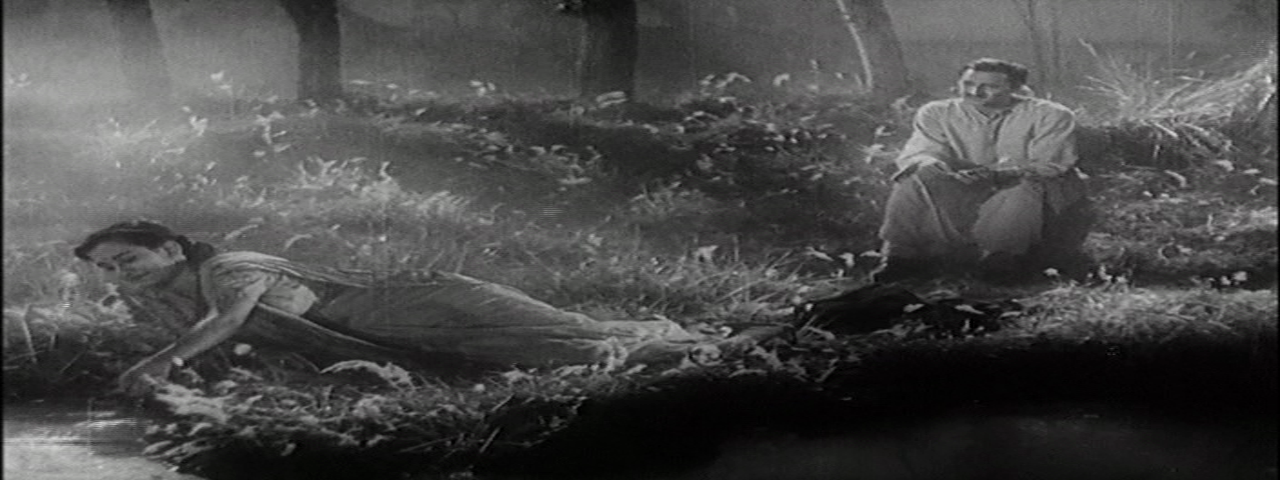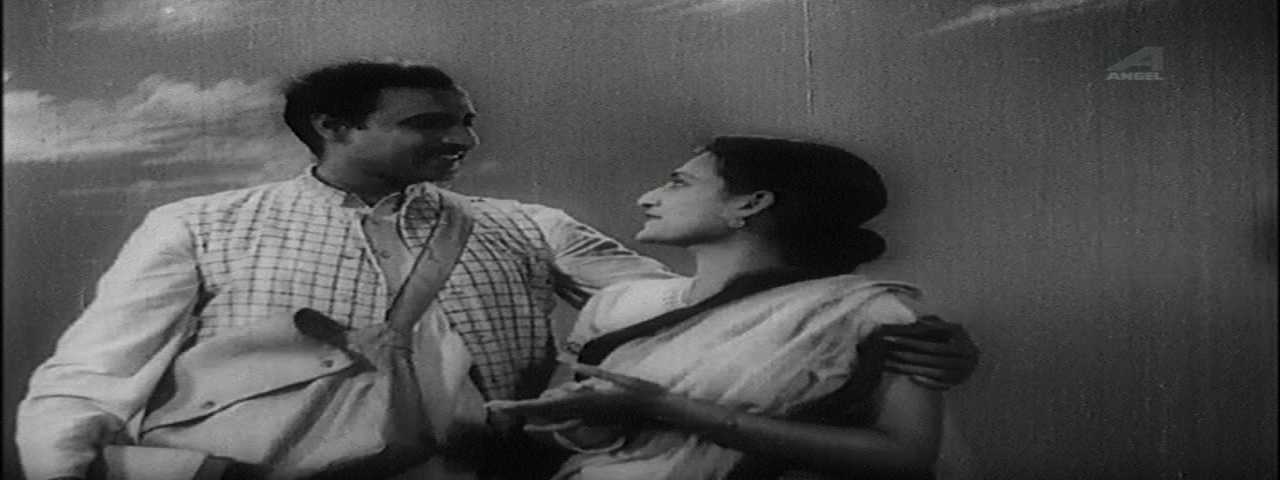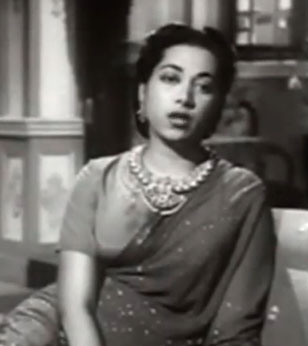This first appeared as "Udayer Pathey: Bimal Roy's realistic inference of socialism" at dearcinema.com on
January 5, 2013.
 |
| Radhamohan Bhattacharya and Binota Bose in the film |
Before soaring to pan-India—and, indeed, international—fame
with Do Bigha Zameen (1953) that spoke of the travails of Shambhu the
peasant, Bimal Roy had, almost a decade earlier, in 1944, become a household
name in Bengal with Udayer Pathey (Towards the dawn), his directorial
debut in Bengali for Calcutta’s New Theatres, remade in Hindi as Humrahi
in 1945. The hugely successful Udayer Pathey, made by New Theatres on
the smallest budget, actually became the studio’s biggest earner. The music was
by Raichand Boral and the lyrics by Shailen Roy—in addition, the film featured
three very memorable Tagore songs.
Bimal Roy’s works all have a distinct flavor of social
realism about them, and Udayer Pathey is steeped in that flavor. It is
the story of Anup Chaudhuri, an intrepid writer-intellectual who upholds the
cause of the proletariat in a system where the balance of power is skewed
towards the moneyed class. Just the previous year, in 1943, Bimal Roy had made
a documentary for New Theatres on the subject of the moment, the Bengal famine.
Thus, Udayer Pathey came about when the rich-poor divide was in plain
view, and inescapably so. The famine, the inflation of the war years, and the
economic hardships that were the exclusive lot of the poor had irredeemably
polarized the haves and the have-nots into two incompatible camps.
This social divide rings loud and clear in the opening
scenes of Udayer Pathey. A luxurious chauffeur-driven car makes its way
to a poorer part of Calcutta as the wealthy Gopa Banerjee (actress Binota Bose
before she married the film’s story writer Jyotirmoy Roy to become Binota Roy)
drops off her poor classmate Sumita (Rekha Mitra, later Mullick) at the
latter’s home. Inside Sumita’s frugal home, her mother is at a loss about where
to seat the rich visitor who has come to invite her daughter to a niece’s
birthday party.
But for all the lack of material wealth in the house, there
seems to be an abundance of moral and intellectual wealth. Sumita’s brother,
Anup (Anup Lekhak as he is known), quite literally, lives and breathes
celebrated minds—the walls of his room are covered in his drawings of Tagore,
Bernard Shaw, Vivekananda, Aurobindo, Bankim Chandra, Gandhi and Karl Marx. An
amazed Gopa reads out from a Tagore poem that Anup has inscribed on the wall,
which has the words “udayer pathey” in it—the inspiration for the film’s title.
So, before we see Anup, we see the august company he keeps.
 |
| Tagore's poem on the wall of Anup's room with the words "udayer pathey" |
We then see Anup (actor Radhamohan Bhattacharya, until then
cast only in villain roles) return home to find Sumita stitching a frock as a
birthday gift, and he cautions her against getting too close to her rich friend
as he is convinced that her gift will not be appreciated in a society where
price is all that matters. Sumita protests that not all rich people can be
categorized so, but Anup is dead sure that all rich folks look down upon the
poor. Sumita insists, though, that Gopa is different. And the unassuming and
immensely likeable Gopa does seem to be very different from her snooty
brethren.
The class divide is laid out in black-and-white at Gopa’s
lavish house. The birthday party is on with music and dance, and Sumita sticks
out like a sore thumb amidst the rich guests in their finery, and the liveried
servers. (Actress Smriti Biwas—whose chubby face I clearly remember in
Baap
Re Baap, 1955 and
Jagte Raho, 1956—dances to the remarkably
beautiful Tagore song “Basante phool ganthlo,” very aesthetically picturized
with a Nataraja statue, lit with lamps, in the background. I must say that
“Basante phool ganthlo,” in this case visuals included, makes it to my category
of
deeply elevating songs.) The table overflows with expensive gifts, with
people busy discussing who gifted what and how much it cost.
 |
| Smriti Biswas dances to "Basante phool ganthlo" |
 |
| Rekha Mitra as Sumita |
Sumita’s discomfort mounts by the minute and is not allayed
when Gopa compels her to sing. Sumita’s soulful singing only receives a cold response
from the gathering. Then, much to her (and Gopa’s horror), Sumita is accused of
stealing from the gift table. A mortified Sumita faints, and Gopa discovers—in
the folds of Sumita’s sari—the frock that her poor friend had brought along and
was ashamed, perhaps, to leave on the table. The accuser, Gopa’s sister-in-law,
is silenced, and Gopa accompanies her distraught friend home. There she meets
Anup, who is angry to see his sister return crying and refuses to accept Gopa’s
apology on behalf of her family. Anup rubs Gopa the wrong way and, after she
leaves, Anup tells Sumita that her insult at Gopa’s house is an insult of all
the poor by the rich.
Anup ekes out a livelihood through his writing and leads a
hands-to-mouth existence—a fact that, however, does not ruffle him much. When
his newspaper editor gives him the lead for a position as publicity officer at
Modern Industries Ltd., Anup gives it a shot and meets the boss’s son there who
is in charge, Shouren Banerjee (actor Devi Mukherjee), who is impressed by the
candidate’s writing talents and extends a job offer. Anup accepts it for the
sake of his family though he isn’t exactly thrilled that he has traded in the
unfettered world of literary writing for the fettered world of publicity
writing.
 |
| Devi Mukherjee as Shouren |
At this point, there is a scene, funny in an understated
way, where Anup, his pockets newly full, wakes up his landlord (Tulsi
Chakraborty, whose bulging eyes are etched deeply in the public imagination by
the movie poster for Satyajit Ray’s Parash Pathar, 1958) in the middle
of the night with the rent money. This is in return for the landlord’s demand,
earlier on, of the overdue rent from Anup at an odd hour.
Shouren greedily eyes Anup’s writerly imagination and, when
Shouren is asked to deliver a speech at the local university’s student union,
he orders Anup to write the speech for him, which, he specifies, be peppered
with grand words like bourgeois and democracy while also condemning the rich.
The dialogue between Shouren and Anup brings out the contrast between the
former’s smug, cocky thinking and the latter’s socialist thinking. The
cigar-toting Shouren tells Anup that the rich are unshakably at the top of the
social order and condemning them is just for the sake of winning popularity
from the students. Anup retorts that the rich are at the top only because they
possess the means to do so: they buy their way through. When Shouren
condescendingly points out that it is the rich who create job opportunities for
people like Anup, the latter notes that these jobs barely provide subsistence.
Indeed, as the socialist argument goes, in the capitalist
system profits are flagrantly tilted in favor of those who own the means of
production. The rich have the means, which the poor don’t, and that is what
makes all the difference. The socialist framework of Udayer Pathey plays
out in the context of the nationalist struggle against British rule. With
economic and political subjugation thus inextricably intertwined, the film’s
capitalist-worker divide is concurrent with the ruler-ruled—and
West-East—divide of the times. So, in this scene it is not at all surprising
that Shouren and Anup, in addition to mouthing ideologically opposing lines,
are presented in Western, and Indian, clothes, respectively—and thus visibly positioned
as opposites.
Shouren delivers the ghostwritten speech to much acclaim,
and soon Anup arrives at his boss’s house to ghostwrite, in the comforts of a
fabulous home library, another speech. Shouren shows off his original Jamini
Roy painting—and this reminds the viewer of the earlier scene where Gopa sees
Anup’s room covered in wall drawings and Sumita explains that her family cannot
afford to buy paintings. Shouren says rather proudly that while he has a book
collection spanning all subjects, he is too busy to read. Clearly, Shouren owns
these status symbols not out of any genuine appreciation but because he has the
brute means to buy it all, like a wholesaler does.
Anup sees Gopa at Shouren’s house (in keeping with the small
world of filmi melodrama, she predictably turns out to be Shouren’s sister) and
realizes that this is the house where Sumita was once humiliated. He resigns
his job right away, actually glad to have the justification to quit working for
a rich man. A persistent Shouren, who tries to write the speech himself and
gives up, reaches Anup’s house to ask for forgiveness from Sumita and even
promises that he will publish Anup’s novel. Anup returns, not so much to see
the novel published, but because of his earlier promise of writing Shouren’s
speech.
Gopa comes across Anup’s manuscript called “Purbachal” and
is totally absorbed by its stark depiction of the lives of the working class.
She has questions for Anup who is glad that the book has made her think outside
of her class. When Gopa wonders if the homelessness and the poverty are really
all that dire, Anup remarks that the very fact that she has to be told about
such an obviously grim reality (and does not know it for herself) is
disturbing, and indicative of the insensitivity of the rich. From here on, Gopa
and Anup warm up to each other. Sure enough, the next time she goes to meet
Anup, she wears a simple sari and happily drinks tea from a handleless cup; she
also accompanies him to the huts of factory workers.
Meanwhile, Shouren acts foul: he publishes “Purbachal” under
his own name. Anup is not shocked, but Gopa is, and she tells Anup that he must
confront Shouren. Anup is surprised to see Gopa upset and in tears but he is
too disgusted to pursue the matter. He happily realizes that Gopa is very
different from her ilk and his regard for her goes up. Shouren’s friends all
fawn over him and compliment him on his first-hand knowledge of the hardships
of workers. Gopa boycotts the celebration at an expensive restaurant and
instead she and Anup attend the workers’ union meet at a hut. Roy juxtaposes
the party where food is overflowing and laughter is hollow, with the
tension-filled hut where Gopa sees a poor child who has not eaten in two days.
The growing bond between Gopa and Anup is further cemented
as they take a stroll together and, appropriate to the context of the
moonlight, Gopa sings the soothing “Chander hashi badh bhengeche” by Tagore,
with the fog rolling in ethereally. The magic of the scene is unmissable.
 |
| "Chander hashi badh bhengeche" and the fog |
When Shouren hears of a workers’ protest in the offing and
is told that Anup is behind it, he promptly bribes a worker to disrupt the
event. When Gopa overhears her brother, she rushes to the meeting just in time
to see a riot break out and Anup hit with a stone. An annoyed Shouren pulls his
sister away from Anup, but the damage is done: the newspaper headlines scream
of the love between factory owner’s daughter and labor leader. As matters get
out of control at the workplace and at home, Shouren’s father, Rajendranath Banerjee
(actor Bishwanath Bhaduri), enters the picture and tries to make peace with
Anup—buy his loyalties, rather. Anup feels contempt for his boss’s manipulative
tactics and refuses to oblige. Shouren then lies to Anup that Gopa is sorry
about her friendship with a person beneath her class. Anup’s face falls as he
hears this.
A disillusioned Anup sends his mother and sister away to the
village, and is planning to leave Calcutta soon. As he tears asunder the
newspaper with his and Gopa’s pictures, Gopa shows up and is surprised to see
Anup suddenly cold and distant. She clears up his misunderstanding and tells
Anup to take her along, wherever he goes. Gopa’s father, meanwhile, desperate
not to lose his daughter, tries to fix her alliance with a wealthy friend’s
son. He visits Anup and requests him to give up Gopa. Anup promises, but
apparently Gopa’s mind is made and she puts on a dour expression when her
brother arranges her meeting with the suitor.
Meanwhile, thinking that it is Gopa who has had their demands
met, the workers go to her house to thank her and invite her to a felicitation
function. Gopa replies that the credit should go to Anup, and the workers reply
that he is going away and give her his letter addressed to her father. Gopa
reads it and realizes that Anup is going away at her father’s request. She
tells her father that she has to meet Anup and when Shouren tries to stop her
from going, Rajendranath stops Shouren. The path clear, Gopa rushes to Anup’s
house, where the landlord tells her that Anup has gone walking all the way to
Asansol (to deal with yet another labor issue). Gopa gets into her car one last
time and catches up with the wayfarer on the Grand Trunk Road, quite the
solitary figure against an open landscape. Gopa tells Anup that she has left
behind all riches to join him in the path of his choice, now hers as well. To
which Anup replies that she has not left behind riches—rather, they lie ahead
in this new path that she has chosen. As the two joyously walk away
hand-in-hand towards the horizon, it is the dawn of a new beginning.
 |
| Walking together on the new path |
Concluding reflections and a postcolonial reading: Udayer
Pathey was, at various levels, an innovative film and one that set the
standards for realism in Indian cinema. It was the first New Theatres film to
touch upon the theme of socialism and, although the film’s decidedly
black-and-white treatment of the rich-poor divide does seem rather simplistic
(and predictable in a filmi way), the exposition of class differences was
relevant at a time of rising national consciousness, when the country was busy
setting aside differences of class, caste, gender, and religion to coalesce
against foreign rule.
The battle that Anup wages against the class divide, and in
which Gopa joins him, is a stepping-stone to the larger battle against
colonialism. The new path that Anup and Gopa together take, in the end of the
film, is a path that will create not just the wealth of classlessness but also
the wealth of freedom and self-governance.
There is a sense in which the larger nationalist aspirations
of the day merge into the film’s socialist aspirations: that Udayer Pathey
opens to Jana Gana Mana (a historic first in an Indian film, although
the scene is missing in the DVD from Angel—was it originally censored by the
British perhaps?), not yet the national anthem in 1944, suggests that the
film’s socialist dream is at once a dream of free India—free from the skewed
power structures of capitalism and colonialism, both of which alienate and
dispossess the worker/colonized. Shouren not just strips the workers of their
rights to a dignified life but goes one step further to villainously rob Anup’s
intellect and his creativity. This sort of an elemental plundering—or ravaging
of the life force—is fundamental to colonialism, which dispossesses not only at
the material level, but also, very significantly, at the inner level. Thus the
image of Shouren in his western suit, throwing his weight around,
unscrupulously appropriating what is not rightfully his, is indisputably in the
colonialist mould. Gopa’s rising rebellion and her final desertion of Shouren,
one of her own, to join hands with Anup—and the people— disturbs the status quo
of the capitalism-colonialism combine and is symbolic of the weakening colonial
grip over India. The path towards dawn at the end of the film presages the path
towards a new, independent India.
On a minor, lighter, and perhaps irrelevant note: I
couldn’t help but notice that people are constantly drinking tea in the film.
And, finally, a question: I have been very baffled
about the missing
Jana Gana Mana in the DVD from Angel. Film historian Firoze Rangoonwalla has clearly stated in a few places that
Jana Gana Mana featured in the film as the opening song—and Radhamohan Bhattacharya, the film's lead actor, has recounted the same. So, then, did the British
cut it in 1944, or did Angel cut it out unimaginatively in recent times? I
emailed Angel and here is the response: “... please note that the original
Video of Bengali Film 'Udayer Pathey' (B/W) was supplied to us by New Theatres
itself. Therefore you are requested to kindly contact representative of New
Theatres directly to clarify the matter.” So far, I have not been able to
locate the contact information for New Theatres. Anyway, I find a very short
excerpt of
Jana Gana Mana in the film in this video
here (starting at 1:21 and ending at 1:35)--which leaves me even more baffled. It
does appear to be in the film, after all. Can anyone please throw some light on
this mystery?
An update: I asked
Mr. P.K.Nair, and he says that the National Film Archive of India's print of
Udayer Pathey, which is copied from the original negative, doesn't have
Jana Gana Mana either. The mystery continues ...
Acknowledgements: I am grateful to: Forhad Hossain of
Fremont, California, for patiently translating the film credits into English
for me; and my cousin Vasanti Muthukumar of Bangalore, for reading out the
names written in Bengali on the walls of Anup’s room from the screenshots that
I sent her.
Disclaimer: My screenshots from the film are used for academic/discussion purposes only; they may be reproduced only if accompanied by a link to this blog.








